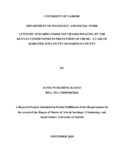| dc.description.abstract | The traditional forms of policing have not been effective in preventing and combating crime in the country. This form of policing is reactive in that it responds to calls from citizens through the SOS, telephone number (999), and the reporting of incidents to police stations. Drugs and substance abuse, robberies, burglary, assault, rape, defilement, illicit brew and other crimes pose a threat to residents of Koibatek and efforts are being made to address them. The purpose of the study was to establish the attitude towards Community Based Policing by the Kenyan communities in the prevention of crime, a case of Koibatek Sub-County, which was aimed at improving security situations in Kenya and challenges faced in its implementation. The specific objectives of the study were; to determine the extent that community partnership approach of the CBP has generated willingness to combat crime, to establish how the residents of Koibatek Sub-County perceives the role of CBP in prevention of crime, to establish whether the residents of Koibatek Sub-County make a distinction between CBP and the Regular Police Service, to determine the extent to which the residents of Koibatek Sub-County has shown commitment to partner with CBP in prevention of crime and to determine the effect of the community partnership approach of CBP in prevention of crime in Koibatek Sub-County. The researcher intended to adopt a descriptive research design. The study population comprised of Koibatek residents with a target population of 1710 respondents from various wards which included Eldama-Ravine, Mumberes/Maji-Mazuri, Lembus, Lembus-Kwen, Lembus-Perkerra and Koibatek. A stratified random sample of 10% of the target population was considered for the study. Data collection was done using Questionnaires, interviews and focused group discussions and was analyzed qualitatively and quantitatively. Percentages measure of central tendency was used for data analysis and presented in frequency distribution tables. The researcher used the statistical package for social sciences (SPSS) computer programme version 23.0 to analyze the data. The findings identified possible gaps and overlaps which assisted the police and the community to understand their level of success. Policymakers and scholars knew their strengths and weaknesses from the research. The drawn conclusion was that the members of the public have a negative attitude towards Community-Based Policing, due to lack of trust in police whom they fear would disclose vital information given to them, hence endangering their lives. They also fear that police misuse them for their own selfish gains, by arresting and releasing criminals after receiving bribes among other reasons. Some of the key recommendations included; creation of job opportunities especially to the youth to empower them economically thus reducing the risk of engaging in criminal activities, joint lectures between the police and the community to be held weekly so that members of the public can become acquainted with the police and also be guaranteed confidentiality of information as they fear victimization, both the police and community to work together if they need to succeed in fighting crime since it is community who knows the people they live with better and are in a good position to provide the police with accurate information about criminals, education and training to be provided to empower both the police and the communities to effectively participate in CBP especially in communities with high literacy levels and teachings on the importance of public participation, human rights and transparency to be provided to both the police and the community. | en_US |



